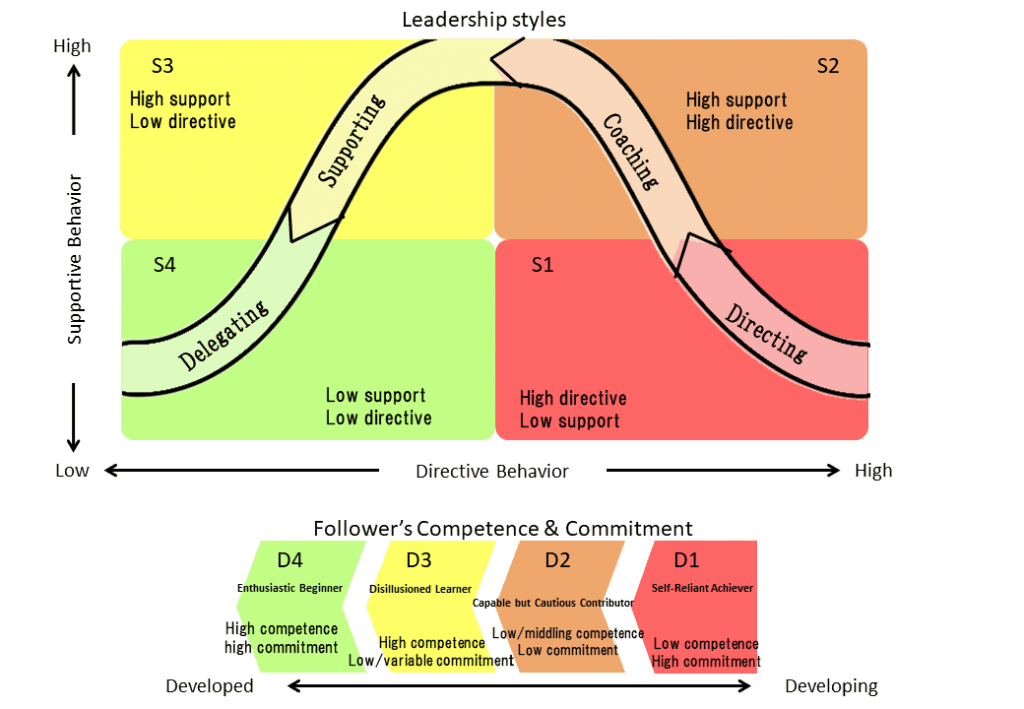Have you led or managed an employee a certain way and it went great but when you tried to duplicate that leadership style with other employees it didn’t go so well? That’s why it’s important to understand the situational leadership style.
I have news for you, many times there isn’t a right or wrong way to lead. Just better ways to lead. Leadership is full of gray areas and it’s your job as a leader to find the best option to get the most out of your employees.
Continue reading to learn how to utilize situational leadership to become a better manager.
Jump To Section
What is Situational Leadership?
All employees are individuals and respond differently to different forms of leadership and management. Understanding each employee and how they react to each style of leadership is key to running an effective work center or team.
Not only are employees different and require different leadership styles, but each situation is different. With all these variables in choosing a leadership style, how do you know what is right to do?
There is a third variable in situational leadership and that’s you. You have to lead in a way still true to who you are. Don’t try to be something you’re not just because you think it’s how you should be. Never forget your values, morals, and ethics. These should always guide you.
To recap, the three things you need to understand as a situational leader are the employee, the situation, and you as a leader.
Why is Situational Leadership Important
Situational leadership is important to provide the right kind of leadership at the right time. Doing this will give you the best chance of success. The situational leadership model offers more flexibility than choosing a certain leadership style and always leading that way.
Although you probably have a predominant leadership style, it’s important to be able to adapt to your situation and the person or persons you’re leading. This will increase productivity, morale, and employee engagement.
Different Leadership Styles for Different Situations
Directing Leadership Style
Directing leadership style is commonly referred to as micro-managing. In this leadership style, you tell your subordinates what to do and how to do it. This can be very useful in situations requiring things to be done in a very specific way. Typically this is best used when you as the supervisor are more experienced than the members of the team.
Coaching Leadership Style
In this situational approach, you are still closely monitoring your employees but instead of directing every single aspect of the job, you guide your team. This is good for when your employees understand the job but may need some motivation. Coaching is a useful tactic to keep your team on the goal and provide motivation.
Supporting Leadership Style
In the supporting leadership style, you give your employees more freedom to make decisions and complete the job on their own. You as the leader are there to support them and help them when they need support. In this role, you try to focus on filling the team’s needs and they get the job done. This leadership style is useful for leading employees who know how to get the job done very well.
Delegating Leadership Style
This type of leadership approach is best for very experienced employees who are self-motivated. These types of employees get the job done with very little to no direction. In this leadership style, you delegate tasks to your employees but after the task is given you are pretty much hands-off. You have to trust that the employee will get the task done. This can give you more time to focus on other tasks.
To learn more about leadership styles read 10 Proven Types of Leadership Styles: What’s Yours?
Practical Applications of Situational Leadership Style
One of the primary applications of situational leadership theory is the assessment of follower readiness. This involves evaluating followers based on their ability and willingness to perform a task.
By understanding the development level of each team member, leaders can determine the most appropriate leadership style to apply. This assessment can be done through observation, performance reviews, or direct communication with followers.
After assessing follower readiness, situational leadership theory helps leaders adapt their leadership style to meet the needs of their followers. This involves choosing the appropriate style (directing, coaching, supporting, or delegating) based on the follower’s development level.
By adapting their leadership style, leaders can provide the right balance of guidance and autonomy, enabling followers to grow and succeed in their roles.
Situational leadership theory can also contribute to positive organizational behavior. By effectively assessing follower readiness and adapting leadership styles, leaders can create a supportive environment that fosters growth and development.
Criticisms and Limitations of Situational Leadership Theory
One of the main criticisms of this theory is the lack of tangible evidence supporting its effectiveness. Although it’s widely used in organizational settings, there are limited leadership studies that provide strong evidence for its effectiveness. This may be because it’s so hard to truly put a number to the effectiveness of a leadership style.
Another criticism is the oversimplification of leadership styles and follower readiness. The theory proposes four distinct leadership styles and four levels of follower readiness, but in reality, leadership and follower readiness can be much more complex and nuanced. Critics argue that this oversimplification could lead to ineffective leadership decisions and limit the ability of leaders to adapt to the full complexity of organizational situations.
Lastly, there’s a potential for cultural bias in situational leadership theory. It was developed primarily in Western organizations, and some question whether it’s universally applicable to diverse cultural settings. Different cultures may have different expectations and preferences for leadership styles and varying definitions of competence and commitment.
Overall, these criticisms and limitations are important to consider when evaluating the effectiveness of situational leadership theory. While it’s a popular and influential approach to leadership, it’s important to recognize its potential shortcomings and continue to explore and develop effective leadership models.
Situational Leadership Style Examples to Enhance Understanding

Example 1
In this example, you have a brand new employee who has never done the job before. What type of leadership style do you think would be best in this situation?
A directive leadership style would be your best bet in this situation because new employees need constant supervision and direction.
Example 2
In this example, you have a task that you and your employees have never done before. One of your most experienced employees will be undertaking this task. What type of leadership style would likely work best for this situation?
A supportive leadership style would probably work best in this situation. Even though you have a task that has never been done before, your employee has proven they can do the job. You should help the employee by facilitating what they need to get the task completed.
Example 3
In this example, you have a very experienced employee and have a task that they have done successfully many times in the past. What type of leadership style should you use?
In this situation, you should be using a delegating leadership style Since this employee has proven themselves on this task it would be a waste of your time to make sure they are doing it right.
Example 4
In this example, you have an experienced employee but they lack a bit of motivation. They know how to do the task you have for them. What type of style would be best for this situation based on what you’ve learned from situational leadership theory?
In this situation, coaching would be best. Even though the employee is fully capable of completing the task, you need to keep them motivated to get the job done.
Wrapping it up
Understanding when to use what type of leadership style is very important in getting the most out of your employees and getting the job done. Getting stuck in one type of style can be counterproductive. For example, If you use a directive leadership style on experienced employees they will begin to feel like you don’t trust them. This will lead to a lot of dissatisfaction and will productivity will be lowered or worse these employees will begin to look for new jobs.
Knowing when to use which type of style will increase morale and productivity. The first step in putting this lesson in leadership into action is recognizing what you are currently doing. Many times, supervisors get stuck in one extreme of either directing or delegating too often. Look at situations in your life where you should have used a different style and try to use the right form of situational leadership going forward.
I hope you enjoyed this brief article on situational leadership style. Please don’t forget to share using the buttons below.



